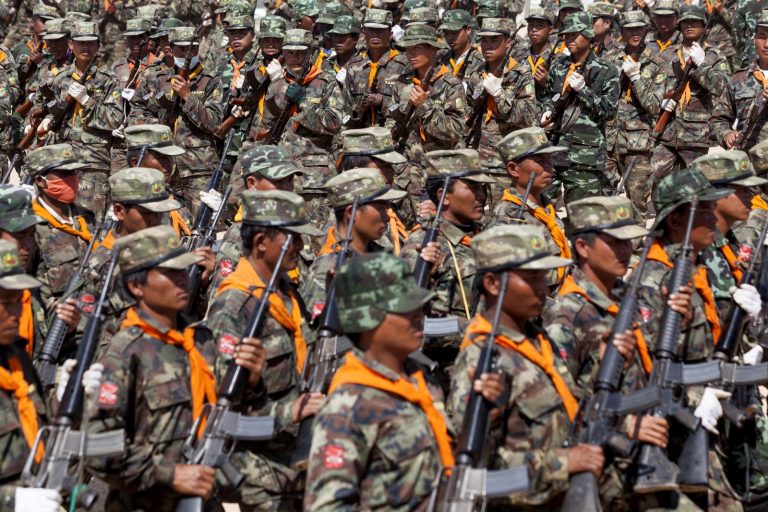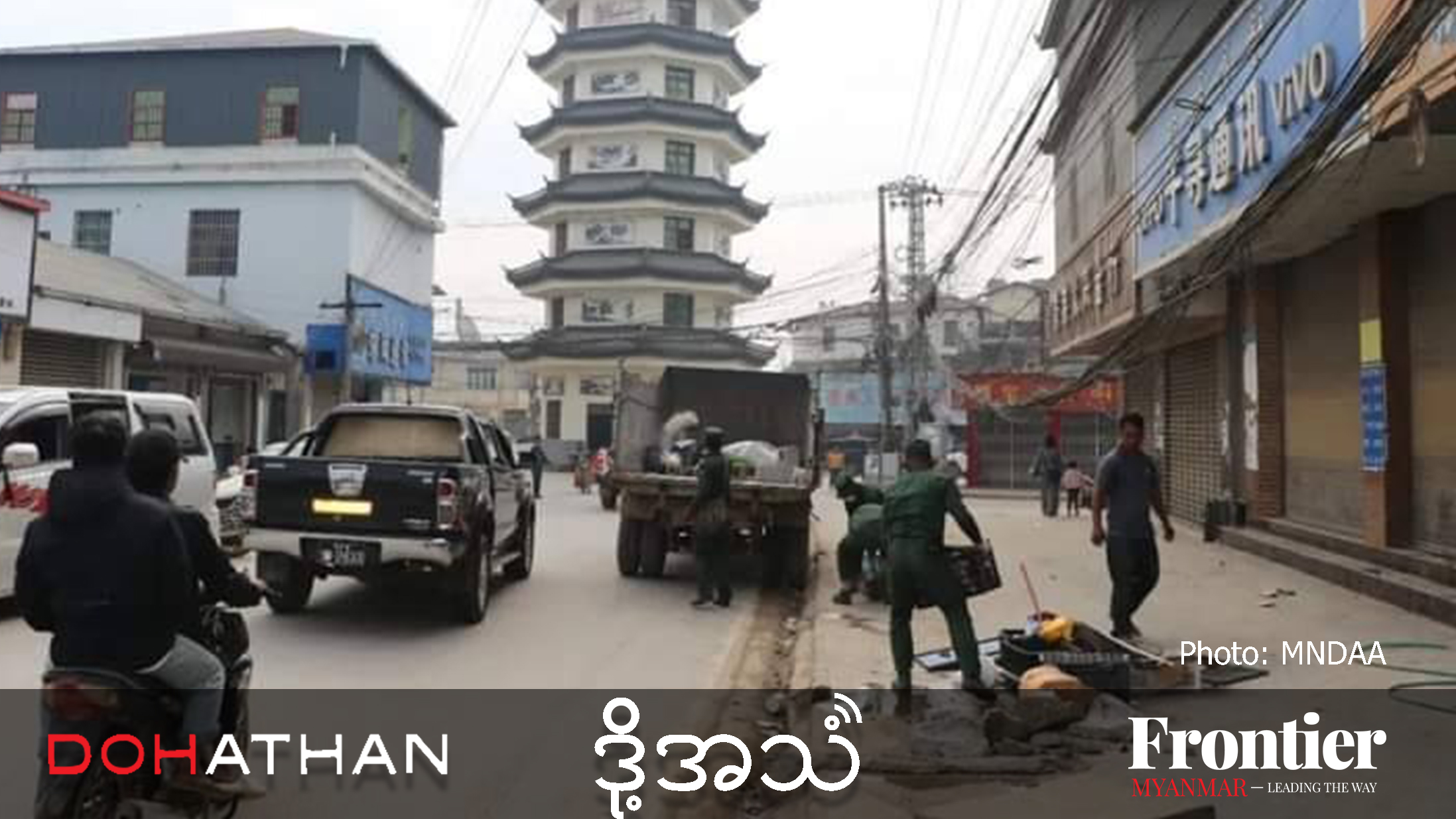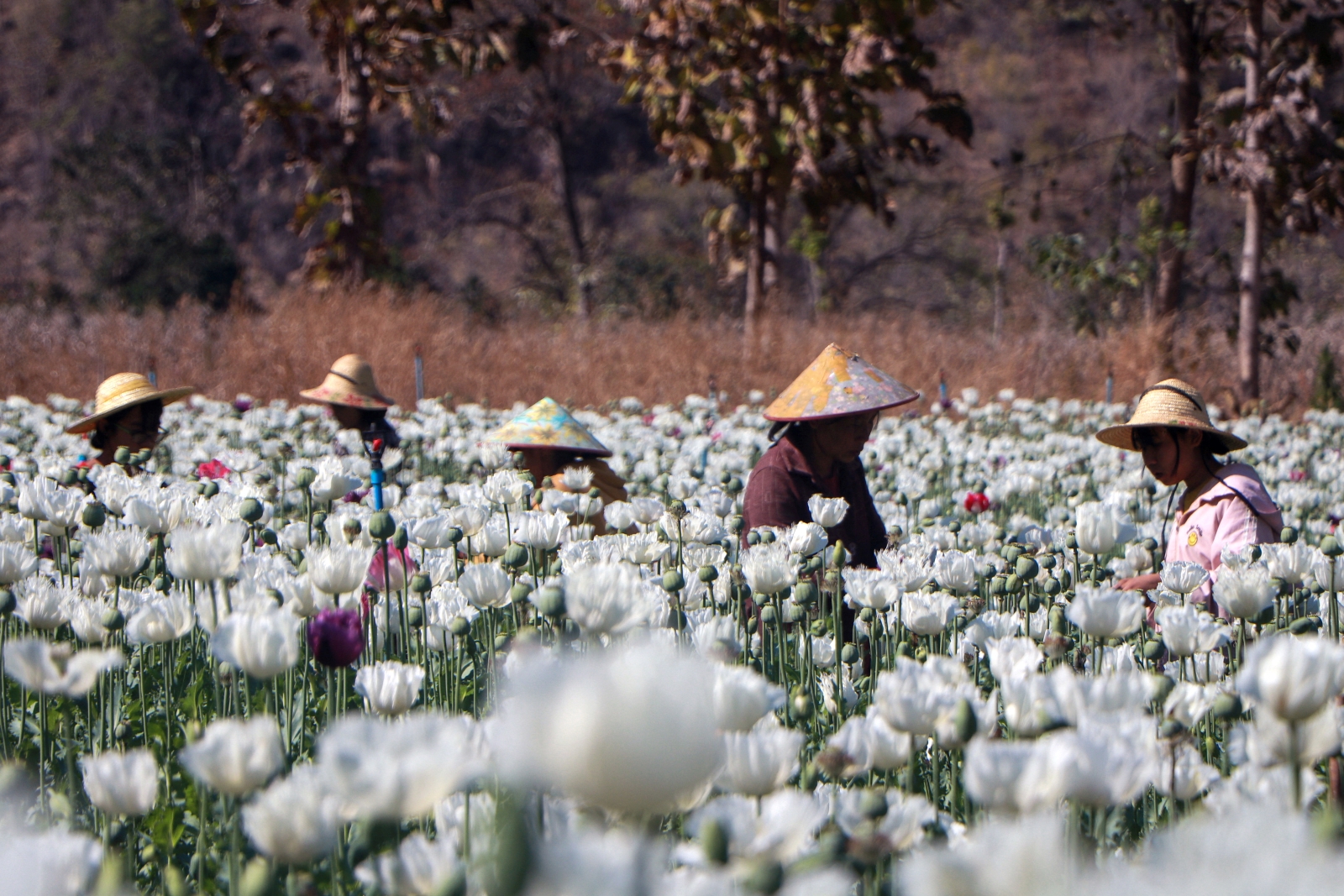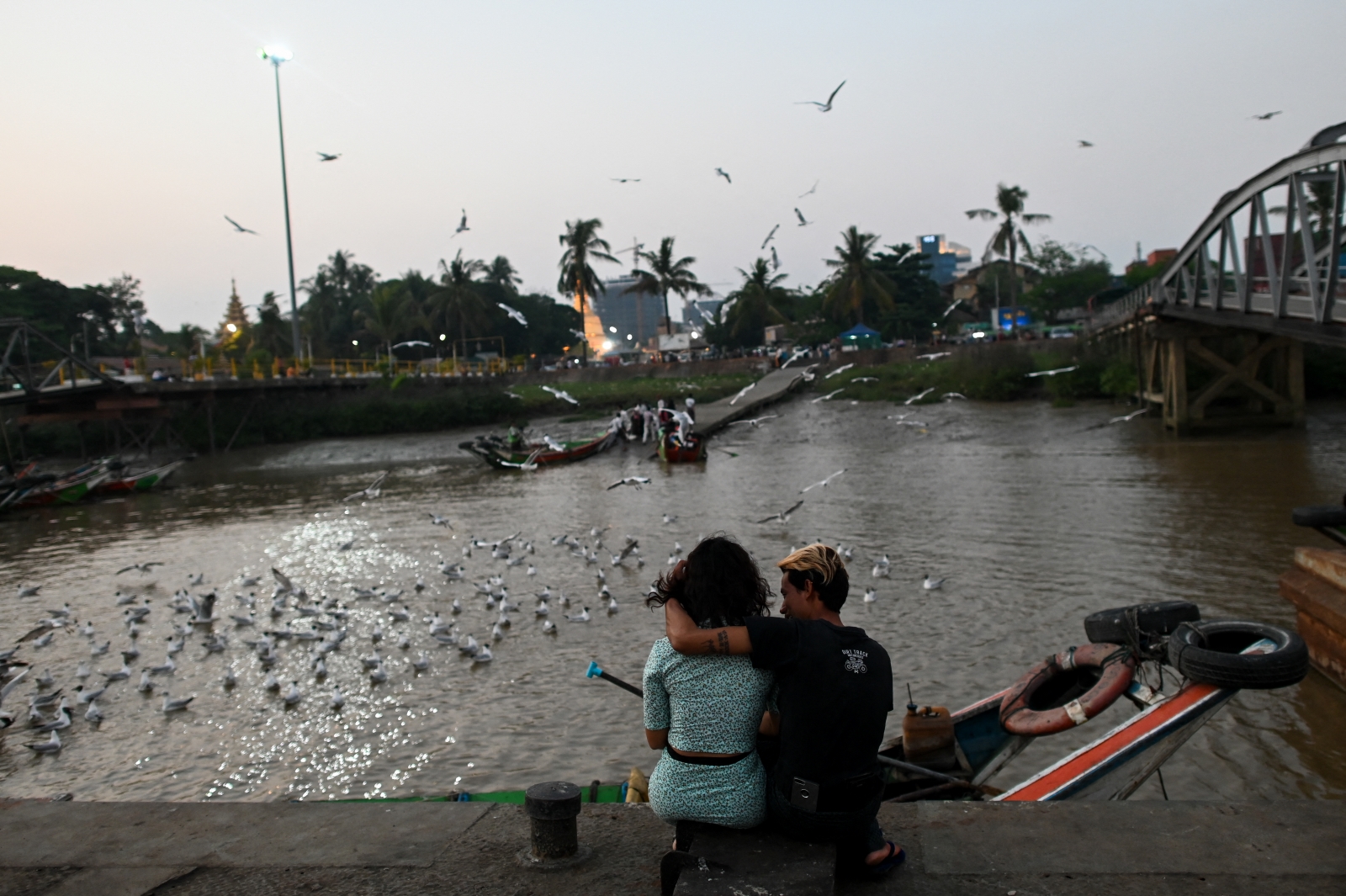Nationalist protests are spreading across Myanmar with an unusual target – military leader Min Aung Hlaing – while the level of organisation and funding suggests they may have the backing of some factions of the military.
By FRONTIER
A sea of 2,000 people shuffled through the empty, sunlit streets of Taunggyi on January 12. Members of the crowd absentmindedly waved rainbow-coloured Buddhist flags while police provided security – a far cry from the 2021 pro-democracy protests, when police officers helped soldiers massacre hundreds of demonstrators.
“We don’t want the terrorist groups destroying Buddhism on our land,” chanted the monks leading the procession in the Shan State capital. “We don’t want, we don’t want,” the people called back.
Buddhist nationalist demonstrations have a long tradition in Myanmar, with some held shortly before and after the 2021 coup to show support for the military. They have seen a recent resurgence in the aftermath of Operation 1027, a military offensive launched by the Three Brotherhood Alliance of ethnic armed groups in late October.
The Myanmar National Democratic Alliance Army and Ta’ang National Liberation Army seized a number of major towns and border crossings with China across northern Shan State, but the MNDAA provoked a nationalist backlash when a video emerged of one of its troops damaging a Buddhist pagoda with a hammer. According to social media monitoring by Frontier, there have been protests in at least 40 townships since that incident, seemingly with bigger crowds than usual.
But some of the participants at the rally in Taunggyi later told Frontier that they were deceived or pressured into joining the event by local regime officials. Daw Mu*, whose family is renting a home in Taunggyi after fleeing clashes in the Kayah State capital Loikaw, said the ward administrator tricked many displaced people into attending.
“They have us registered on the household lists. He [the administrator] told me there was an event for displaced people – he never mentioned anything about a protest – and therefore each family needed to send at least one member to the football stadium in the morning,” she said.
It wasn’t until she arrived that she realised she had been duped, but at that point she was too scared to defy the organisers.
“I was very upset when I realised I had been deceived. When I saw it was a nationalist protest I wanted to leave right away. But there were many nationalist activists and police surrounding and managing the march. So I didn’t dare leave and walked with them for an hour,” she said.
But while such protests against ethnic armed groups are par for the course under military rule, these protests had a more unusual secondary target – Senior General Min Aung Hlaing.
Losing patience with ‘Ko Thein Aye’
Ultranationalist monks including Naymingyi Sayadaw at the Taunggyi protest, U Kaythaya in Yangon and Pauk Ko Taw in Mandalay have all demanded that Min Aung Hlaing step down as commander-in-chief given his battlefield failures during Operation 1027.
During a January 21 rally at Sule Pagoda in downtown Yangon, one of the most important Buddhist sites in the country, U Kaythaya even tauntingly referred to Min Aung Hlaing as Ko Thein Aye – a nickname based on a play on words mocking him for being ineffective after seizing power. Like many others, U Kaythaya demanded that Min Aung Hlaing step down in favour of his deputy, Vice Senior General Soe Win, who is widely respected within the military.
While some attendees were threatened or deceived, others did go to the rallies willingly. A nationalist monk from Yangon’s Insein Township who was present at Sule said the rally was intended to lift the spirits of the nationalist community.
“In fact, most of them are depressed and worried because of the Tatmadaw’s defeats,” he said, speaking on the condition of anonymity. “Some may be wondering if they were wrong to support the military. That’s why we want to show that there are still many people on their side. The rallies are to give them mental strength.”
Naymingyi Sayadaw, meanwhile, has been building a Buddhist nationalist support base among local members of the Pa-O ethnic group for years.
“Since 2016, he has visited Pa-O villages and convinced the villagers to join his so-called National Security Network. He is one of the monks leading pro-military activities here, and has a close relationship with the generals and the [allied] Pa-O National Organisation militia,” said Khun Lar Bwal, a member of the anti-coup Pa-O National Defence Force.
The coup has riven the Pa-O community, which predominates in the Pa-O Self-Administered Zone consisting of Hopong, Hsi Hseng and Pinlaung townships in southern Shan State, as well in as nearby Taunggyi. The SAZ is dominated by the PNO, which has continued to cooperate with the military, while disgruntled youths formed the PNDF to fight against the regime. In January, the formerly neutral Pa-O National Liberation Army dramatically entered the fray, claiming it seized control of Hsi Hseng town with the support of other resistance groups, including the PNDF.

Lar Bwal said some Pa-O people do participate in the nationalist protests willingly, because of their strong attachment to Buddhism and the belief that the military safeguards the religion. It makes him sad to see honest Pa-O being used in the military’s “political games” because of their faith, but he said the younger generation is free from this “brainwashing”.
“We want to urge PNO to stop working for the military and follow the desires of the Pa-O people,” he said.
A rival power centre?
Daw Mu, who was deceived into participating in the Taunggyi protest, said afterwards the ward administration office distributed rice, cooking oil, chicken eggs and beans to the displaced families.
Khun Thar Oo*, a Pa-O resident of Pinlaung Township, similarly told Frontier that he was threatened, and then rewarded.
“If there is a rally to support the Tatmadaw in Taunggyi, the village leader collects people in trucks even if we don’t want to go. If we refuse, they threaten to call the army or militia groups. If we follow, they give us K10,000 or K15,000,” he said.
The organisation and funding of these protests has led some to suspect they are backed at least by a faction of the military.
“This shows the military is in chaos,” said U Waryama, a leading monk in the pro-resistance Spring Revolution Sangha Network. “These protests are very expensive and can’t be held without the support of the military. If monks close to the military told Min Aung Hlaing to resign, it must have come from within the military.”
A previous Frontier report found deep dissatisfaction within the military with Min Aung Hlaing’s leadership, with a major-general even calling him “the worst leader in the history of the military”.
The Insein-based nationalist monk interviewed by Frontier said military officials and regime administrators contributed funds to the January protest but refused to reveal more details. He also admitted that, despite the provocative nature of the demonstration, authorities didn’t summon any of the organisers for questioning, although they did question Pauk Ko Taw in Mandalay.
Anti-coup activist Ko Thet Swe Win agreed that the protests are evidence of a widening split in the military, but said this is not necessarily good for those opposed to military rule.
“We can see the splits between them, but if there is a leadership change, there’s no hope it will be better for our revolution. Because their demands show they want a leader who is more ruthless than Min Aung Hlaing,” he said.
Indeed, most military supporters interviewed by Frontier since the coup have criticised Min Aung Hlaing not for his many human rights abuses, but for his inability to crush the opposition. However, it remains unclear if anybody within the Tatmadaw will move against the commander-in-chief, due to the military’s culture of loyalty and obedience, its internal surveillance and the 13 years Min Aung Hlaing has spent consolidating his power over the ranks.
Political analyst U Than Soe Naing said it’s unlikely Min Aung Hlaing would be removed unless he lost control of Lashio, the largest city in northern Shan, or Pyin Oo Lwin in Mandalay Region, home of the foremost officers’ training school. Military sources had also identified Lashio as a red line in Frontier’s earlier report. TNLA forces surround both towns, but the group has largely observed a ceasefire brokered by China in January.
If the towns were to fall, Than Soe Naing predicted Min Aung Hlaing would either flee abroad or try to use his most important political prisoner – civilian leader Daw Aung San Suu Kyi – to negotiate a compromise with the resistance.
But some, like U Waryama, are still taking encouragement from the military’s disarray.
“It’s obvious how afraid they are,” he said of military supporters. “They know that if the revolution succeeds, their nationalist groups and monks will lose their place in society.”
*indicates the use of a pseudonym for security reasons







